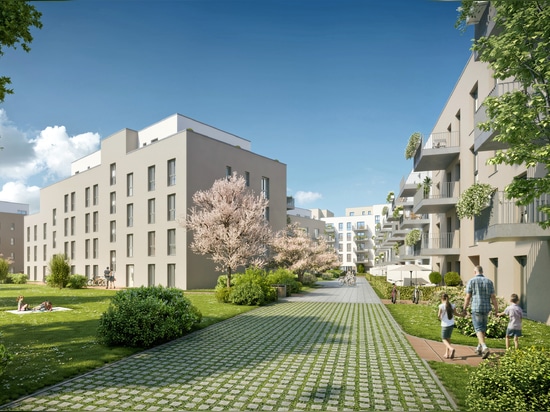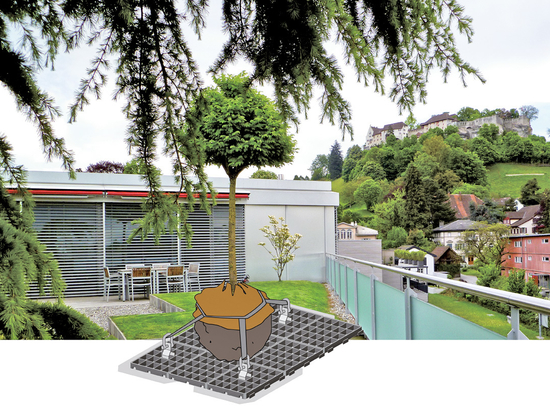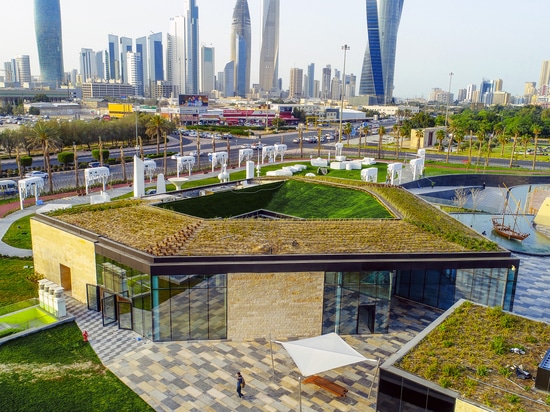
#Product Trends
A textbook example of a “Stormwater Management Roof”
Residential development Noltemeyer Hoefe in Braunschweig
In matters of ecology and sustainability, designers and architects are likely to pay increasing attention to roofs. The huge potential here is illustrated by the residential development, Noltemeyer Hoefe in Braunschweig, with its 5,780 m² of green areas, terraces, pathways and driveways, where cars are parked out of sight in the underground garage. The key feature is that the system build-up “Stormwater management roof” can store large volumes of rainwater and release them again at pre-set times. A prime example of urban development for the future.
Noltemeyer Hoefe on Hildesheimer Strasse, within the western ring road of Braunschweig, is a residential development consisting of six apartment blocks with 242 apartments covering a total area of approx. 16,000 m². Each of these upmarket residential units has a balcony, loggia, patio or a roof garden and therefore a close connection between the inside and outside world. 232 underground parking spaces are concealed beneath a landscaped terrain comprising lawns, trees, bushes, hedges and ground cover, in addition to pathways and driveways, and 22 overground parking spaces. However, apart from the optics, a very different feature provides the key benefit here in terms of ecology and sustainability.
Protection from flooding included
The trick is in the ZinCo system build-up used across the entire 0°-pitch underground garage deck: this is a “Stormwater management roof” which can store large volumes of water during heavy rain events and can release the water into the sewer system at a time delay. The special retention spacers RSX 80, together with the precision-adjustable run-off limiter elements, comprise this perfect technology.
Using a root-resistant roof waterproof membrane as a base, which was applied in the hot bitumen method, the stable Slip Sheet TGF 20 and the system filter PV were installed as a protective layer. The next layer consists of the RSX 80 retention spacers, 0.60 m × 0.60 m large and 80 mm deep. These spacers, which can withstand loads of up to 50 t/m² and are therefore also suitable for driveway surfaces, were fixed to each other with connectors to create a continuous surface. The project-specific special depth of 80 mm allows for a maximum storage volume of approx. 76 l/m². In relation to the overall area of 5,780 m², this corresponds to a calculated storage volume in the retention spacers of an incredible 439,280 litres of water, which is released into the sewer system over a pre-defined period (of about 24 hours). The flow volume is regulated with rings that move against each other in the throttle elements, which also function as an overflow.
Anything is possible on top: Surfaces and green areas
After the retention spacers, the system filter PV is installed and an average of 20–30 cm of Zincolit Plus as a substrate base for the planned 2,320 m² of greenery, and 30 cm of the system substrate “Roof garden”. Given the stable sub-structure which protects the waterproof membrane, it was no problem driving the diggers around the roof area in order to apply the substrate.
The system filter PV was followed by 20–30 cm of sand-stone mixture as a frost protection layer for the required 790 m² of pathway, 20 cm of gravel base layer and finally 5 cm of grit. An 8 cm thick rectangular paving is installed in a herringbone pattern on this bedding.
These dimensions and the type of installation were also chosen for the 1,940 m² of driveway surface. The special herringbone pattern prevents the paving from shifting, which would otherwise occur with cars, refuse and emergency vehicles driving on it. Beneath this is a 40–60 cm, somewhat deeper gravel base layer and a 5 cm grit bed. Grass paving was laid on the area for the fire service vehicles. Seepage-active surfaces such as these ensure a rapid surface drainage in the case of heavy rain events.
The use of solitary trees and shrubs in the middle of extensive lawn areas gives the residential area an expansive feel. Among the different types of greenery – 20 types all in – benches and playground equipment are an invitation to young and old to come and spend a while there.
Urban development of the future
The residential development, Noltemeyer Hoefe, is an impressive example of how stormwater management roofs are a proven means of reducing the risk of flooding today. Rainwater retention, green recreation spaces, ecological compensation areas, improvement of the micro-climate, dust and pollutant binding, the protection of the building substance – the number of sustainability elements possible on roofs is infinite. All of these elements should and must be exploited in order to build ecologically into the future.





